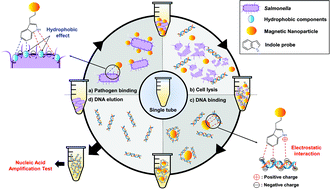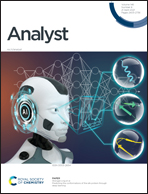Tryptamine-functionalized magnetic nanoparticles for highly sensitive detection of Salmonella typhimurium†
Abstract
There is significant demand for the development of rapid, sensitive, and specific methods for detecting bacterial pathogens in order to identify the causes of food poisoning. Nucleic acid amplification tests (NAATs) allow for the culture-free detection of bacterial pathogens and are not as labor intensive and time consuming as culture-based detection methods. However, suitable sample preparation methods must be developed for the realization of simple, rapid, and sensitive NAATs. To resolve this problem, we developed a new sample preparation method that integrates bacterial pathogen enrichment and DNA extraction. We engineered magnetic nanoparticles (MNPs) with a physicochemical probe (tryptamine) for single-tube sample preparation with minimal sample loss. The tryptamine-functionalized MNPs (Indole@MNPs) showed inherent hydrophobicity owing to the indole side chain and a change in their zeta potential with a decrease in the pH. Because of their physicochemical characteristics, the Indole@MNPs could adsorb bacterial pathogens, thus allowing sample enrichment and DNA binding and release through weak electrostatic interactions via pH control. We successfully detected Salmonella enterica serovar Typhimurium, a common cause of bacterial food poisoning, at a concentration of 10 CFU/10 mL in milk samples using quantitative PCR. Thus, the proposed method allows for the simple and sensitive detection of Salmonella typhimurium and can be used for nontyphoidal salmonella detection to ensure food safety.

- This article is part of the themed collection: Analyst Recent HOT articles


 Please wait while we load your content...
Please wait while we load your content...